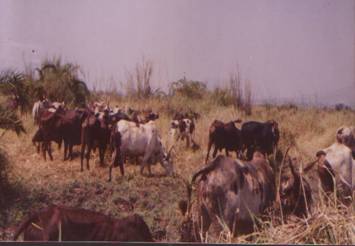|
<<<,Home page
<<<Website Contents
1 | 2 | 3|
4 | 5 | 6|
7 |8 | 9|
10 |11| 12
13| 14 | 15
16 | 17 | 18
19 | 20 | 21
22 | 23 | 24
25 | 26 | 27
28 | 29 | 30
31 | 32 | 33
34 | 35 | 36
37 | 38 |39|
40 | 41 | 42
43 | 44 | 45
46 | 47 | 48
49 | 50 | 51
52 | 53 | 54
|
Theme: THE DEGRADATION OF WETLANDS AND ITS SOCIO ECONOMIC AND ENVIRONMENTAL IMPLICATIONS IN NDOP CENTRAL SUBDIVISION, NORTH WEST PROVINCE CAMEROON
Page 68
These movements are represented cartographically as seen on (figure14). From here it can be seen that the movement of cattle into this region is intense. Apart from Bamunka and Bamessing in which cattle rearing records over 967 cattle in Ndop Central Subdivision, a total number of about 7216 cattle found in this region during the dry season come in from other regions like Jakiri, Sabga and Awing, which are almost devoid of pasture during the dry season.
The presence of cattle in the wetlands (see photo 14) during the dry season spares no chance of existence for the natural vegetation cover in this area.

Photo14. Transhumance on the wetlands of Ndop Central Subdivision.
Source. BongadzemC.S (2006.)
The vegetation is heavily grazed by these cattle, leaving the flood plains bare and devoid of green vegetation by the end of the transhumance period. Streams and ponds are equally dirtied during this period by cattle which trample on and defecate directly into them. Several tons of cow dung is dropped into water at cattle drinking spots. The trampling effect of cattle is also felt on trees and other herbs which, even though do not constitute pasture are broken down during the passage of cows.
Transhumance is also held responsible for the introduction of new species in the wetlands. Cattle egrets which are common in the rice fields come with cattle on which they exhibit symbiotic feeding relationships. Concerning flora species, the locally called ¨onion grass¨ (Scirpus jacobi) is believed to have been brought into the rice fields by cows whose dung contains seeds of this grass which were consumed in other areas. These species have ravaging effects over local species in the area.
Boutrais .J, 1975 carried out studies on transhumance on the Ndop plains. During this period, the activity regrouped only about 2500 cows as opposed to about 8185 cows
55 | 56 | 57 | 58 | 59 | 60| 61 | 62 | 63| 64 | 65 | 66| 67 | 68 | 69 | 70 | 71 |72 |73 | 74 | 75
76 | 77 | 78 | 79 | 80 | 81 | 82 | 83 | 84 | 85 | 86 |87 | 88 | 89 | 90 |91 | 92 | 93 | 94 | 95
<<<Back to table of contents || Go to next page>>>
|
